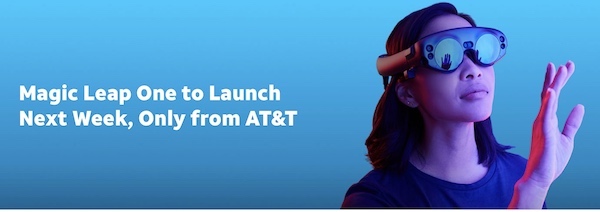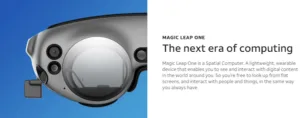In July 2018 AT&T became one more company investing into Magic Leap. Remember this all happened before Magic Leap actually released a product to the market. With over $2 billion of investments, Magic Leap is one of the most well funded and most secretive start up companies ever. While AT&T did not disclose how much they invested into Magic Leap, they did state that “AT&T will form an exclusive US Consumer relationship” to expand the future of spatial computing.

In November of 2018 AT&T hosted a Magic Leap Hackathon and announced the installation of a 5G mobile network at the Magic Leap campus in Florida.
Now AT&T announced that they are offering the Magic Leap One headset at AT&T flagship stores in Boston, Chicago and San Francisco. While the price of $2,295 seems a little bit prohibitive to go mainstream, the fact that AT&T is offering consumers the chance to come in and try out a headset is a very interesting approach.
 Magic Leap One available from AT&T; credit AT&T
Magic Leap One available from AT&T; credit AT&T
So where am I going with this?
Think back several years and remember the analysts that were questioning Apple on how many “Smartphones” they might be selling. As a reminder it was about 1.4 million for 2007 and went up from there to about 215 million per year in recent years. The price was $500 to $700 depending on the memory in the phone. More interesting was the fact that the iPhone was available only through AT&T and required a two year contract. So the wireless plan subsidies were born. AT&T was smart enough to foresee that mobile data would be the driver of future profits. This was at a time when calling plans in the US were mainly built on minutes per month.
How much an iPhone really cost back then was not clear as the first unlocked iPhones were not available until 2011 and cost between $650 to $850 for the latest model. Back in 2007, the first iPhone may have had a sales price of $1,000 and may have been actually unsellable as a stand-alone transaction.
So, here we are again.
The Magic Leap One costs $2,295 and I’m not sure if this includes a data contract from AT&T or not. But there are two issues why this AT&T approach seems to be noteworthy. First of all, there seems to be a connection between 5G and Augmented Reality. Of course WiFi will be the connection of choice in the beginning and maybe even preferable from a power demand standpoint, but it limits the usage to a WiFi source and that excludes walking through a city with the headset on. Indoors is still a possibility, but the ultimate goal for AR headsets of being used everywhere does require a good and fast data connection. It seems that LTE does not really fit the bill at the moment.
If anybody asks what is going to use all the 5G bandwidth that is being discussed, AT&T seems to think that AR is a very good candidate at the moment. Of course, 5G will also be great to power all our web browsing and video watching on our mobile devices, AR just adds to this.
On the other hand, as mobile data is the major stream of income for the wireless companies, they have to look out for new technologies that could threaten their main income stream. So the question is how strongly AT&T believes that AR will create a new income stream for them? One hint is that AT&T considers the Magic Leap One to be a lightweight, wearable computer. Nowhere on their webpage is there a word about augmented reality or any other reality term. Instead they talk about ‘enriching the real world experience with digital content’ and spatial computing. Get it? Digital Content! This does include DirectTV Now to be available on the Magic Leap One.
Magic Leap One, the next computing platform?; credit AT&T
They even have a little YouTube video, online since October of 2018, that shows this content distribution idea in action. Live streamed content would definitely make a contribution to data usage and therefore their bottom line.
This means that the available bandwidth and the actual mobile data demand must grow somewhat in parallel. The release of 5G promises a significant increase in bandwidth while costing a lot in up-front investments. If the bandwidth promise of 5G is realized and outgrows the data demand, one could argue that selling an AR headset at a big discount and bundling it with a data contract may be the way to go.
We are still very early in the game and looking at the iPhone comparison it feels like we are in 2007 again. The hardware has been announced and it is unclear how consumers will react to the set price points. At a first glance, $2,295 is not a bargain by any means, but it may also indicate that the production capacity at Magic Leap is not that substantial at the moment. And don’t forget that we have no idea what the actual manufacturing cost are for the Magic Leap One without even discussing the upfront R&R cost.
The real question for me is if the subsidy model that worked so well with the smartphones may also work to introduce AR technology to the consumer. – NH

